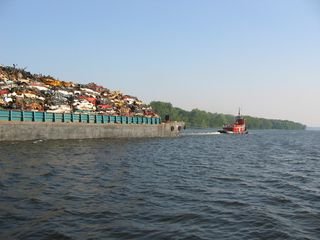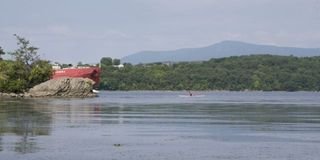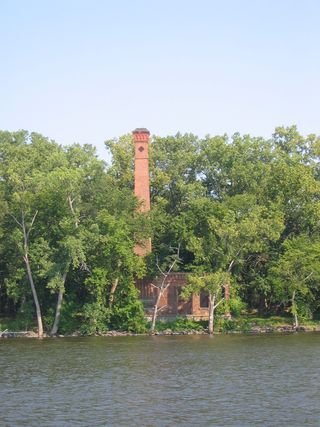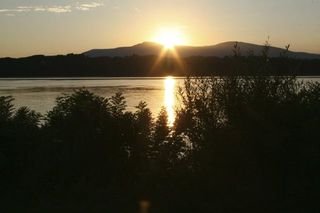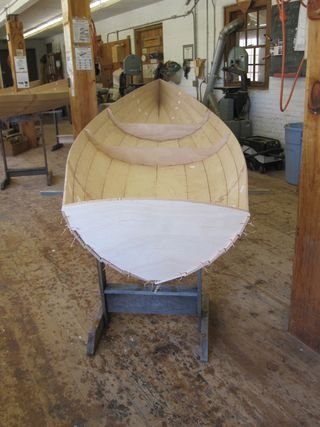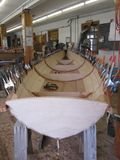Indian Point
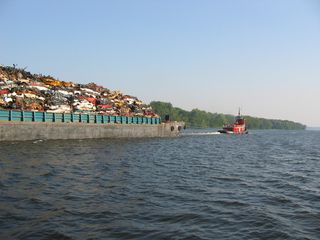
From water level, the towers loomed above me and the entire structure felt imposing. There are layers of red brick buildings smack against the river. Not a window in sight, as if whatever was contained inside shouldn’t be seen, and should not see out. I’d passed some large industry on the river—Trapp Rock up by Poughkeepsie, for instance, but nothing that felt ominous like the Indian Point plant. There are many reasons to protest nuclear power. In my life, the stories of Three Mile Island, Chernobyl and Fukushima are enough to convince anyone this is a risky source of energy. There are many reasons not to want a nuclear power plant so close to a major metropolitan area—9/11 is enough to show how vulnerable we can be. And there are many reasons not to want a nuclear power plant on the Hudson River. The plant rests on a small earthquake fault. And, the plant uses billions of gallons of water t o cool its towers and then spits this warmed water back into the river, altering the ecosystem. In the process, millions of fish are sucked into the plant and killed. But I had not thought about any of this with much care until I stroked past the plant low in my boat.

One spring, I loaded up my kayak with sleeping bag and food and pointed south on the Hudson River. I was traveling with a former student, Emmet, and we intended to take a few days, camping on islands and on the banks of the river, to make our way from my village of Tivoli to Manhattan (I write about this adventure in my upcoming book, MY REACH). This is the freedom of a river, to head out and see what you can see. And I did see many marvelous things on my journey, and lots that I wish I had not seen. Day four I passed the Indian Point nuclear power plant. Instinctively, we scooted to the western shore, giving the plant a wide berth.
From water level, the towers loomed above me and the entire structure felt imposing. There are layers of red brick buildings smack against the river. Not a window in sight, as if whatever was contained inside shouldn’t be seen, and should not see out. I’d passed some large industry on the river—Trapp Rock up by Poughkeepsie, for instance, but nothing that felt ominous like the Indian Point plant. There are many reasons to protest nuclear power. In my life, the stories of Three Mile Island, Chernobyl and Fukushima are enough to convince anyone this is a risky source of energy. There are many reasons not to want a nuclear power plant so close to a major metropolitan area—9/11 is enough to show how vulnerable we can be. And there are many reasons not to want a nuclear power plant on the Hudson River. The plant rests on a small earthquake fault. And, the plant uses billions of gallons of water t o cool its towers and then spits this warmed water back into the river, altering the ecosystem. In the process, millions of fish are sucked into the plant and killed. But I had not thought about any of this with much care until I stroked past the plant low in my boat.
Floating in a kayak on a big river I often feel tiny, especially next to tankers or the barges that shove north and south at all times of day and night (in this photo, a tanker is emerging around Magdalen Island--that little dot is me). But my river view is an important perspective, it’s the same view a beaver might have, or a great blue heron wading by the shoreline. In a kayak, there is an intimacy with the water, whether that water is clean or not, the sights beautiful or not. And I did not like being intimate with a nuclear power plant. It took experiencing the chill of Indian Point on a cool rainy spring day to make me care about shutting down the plant.
And so it comes as good news that Governor Cuomo wants to shut down Indian Point and that new legislation will make this possible. This long battle may finally come to an end. According to Times reporters, Entergy, the company that runs the plant, came away from the meetings “alarmed” with the governor’s direct and strong intentions.
Even though I am skeptical that Indian Point will be shut down, I’m going to be naïve and pretend this is true. I have decided to begin my celebration by wondering what happens to a closed nuclear power plant. Will it join the history of closed industry along the river? When I paddle the length of the estuary, I have passed brick towers that are the remains of the icehouses (photo at left) that stored and brought ice to keep Manhattan cool. There are the sheds that were used in brick making just north of Kingston where teenagers now come to skateboard, the clatter of their leaps and landings echoing through the tall, metal-roofed buildings. There are the remains of the cement industry, and an enormous brick building near the water in Germantown that says “Cold Storage.” These ghosts of industry past I find intriguing, often beautiful. I slip onto shore and out of my boat and poke around these structures, wary of broken glass and often taking a brick as a souvenir. Manhattan is built from Hudson Valley cement and brick. In an odd nostalgia, I wish that this industry were still alive, but cement is reduced to three plants near Smith’s Landing, and the brick industry closed for good in 2001. Yet the end of these industries means a cleaner river, a quieter, calmer river for me to paddle on. One hundred years ago, would I have wanted to see the brick industry close?
So in a hundred years will someone paddle past the crumbling towers of Indian Point and wonder about nuclear power? Perhaps there will be a certain nostalgia as she wishes that we still had that plant generating electricity for New York City. Or will she wonder what we ever imagined was good or sane about nuclear energy?
Solstice Adventures - Tell Me Your Stories

There are many ways to celebrate the solstice. In my mind, having an outdoor adventure is almost required. One year I slipped my kayak into the water before dawn to watch the sun rise while on the river. I paddled north for a few hours, then floated south with the outgoing tide. I was out of the water by noon and had spent eight hours on the river. Already a full day and yet another day’s worth of sunlight stretched before me. This year I intend to do the same: paddle out with the sun.
What I would love is to hear reader’s stories of adventures. Tell me of outdoor adventures you have had or what you intend to do tomorrow. Send your stories as a comment or as an email and I’ll post these to my blog (I am redoing my website; when I am done, there will be a reader’s tales of adventure section).
Tomorrow is June 21, the longest day of the year. When the sun is out or up for so long, I feel the need to celebrate, to be outdoors and play. This desire to take in every minute of sunlight is challenged in places like Alaska, where above the Arctic circle they have 24 hours of sunlight. It’s hard to get any sleep in the summer in Alaska—the sun is intoxicating. And, I think to of those who winter over in Antarctica in 24 hours of darkness.
There are many ways to celebrate the solstice. In my mind, having an outdoor adventure is almost required. One year I slipped my kayak into the water before dawn to watch the sun rise while on the river. I paddled north for a few hours, then floated south with the outgoing tide. I was out of the water by noon and had spent eight hours on the river. Already a full day and yet another day’s worth of sunlight stretched before me. This year I intend to do the same: paddle out with the sun.
What I would love is to hear reader’s stories of adventures. Tell me of outdoor adventures you have had or what you intend to do tomorrow. Send your stories as a comment or as an email and I’ll post these to my blog (I am redoing my website; when I am done, there will be a reader’s tales of adventure section).
My Reach
As I slid my kayak into the Hudson River last Wednesday evening, the water grabbed my ankles. My calf muscles seized with the cold. I tuc 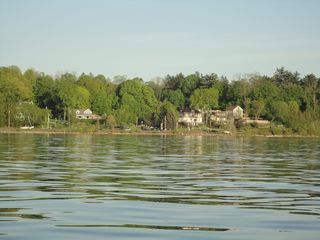
A reach is a stretch of navigable river, often the distance the eye can scan. On the Hudson there are a range of reaches, most with direct names like the Barrytown Reach or the North Germantown Reach. Some have names that have existed since when Henry Hudson sailed up the river in 1609 like the Long Reach off of Poughkeepsie. When Ed Abbey claims the desert in Desert Solitaire as his own, “Abbey Land,” it is because he is the only one there and because he loves it. I too make my claim out of love, but I can’t claim I am the only one on the river. I share my reach with many—many who no doubt imagine that this is their reach as well.
As I slid my kayak into the Hudson River last Wednesday evening, the water grabbed my ankles. My calf muscles seized with the cold. I tuc ked into my boat and settled into the seat of my kayak. I then strapped the sprayskirt tight, before dipping my paddle into the spring-brown water. This was my first time in my kayak on the river this season, a late start for many reasons, but mainly due to our over-rainy spring. I was eager to scout about the section of river off of Tivoli that I think of as my reach.
A reach is a stretch of navigable river, often the distance the eye can scan. On the Hudson there are a range of reaches, most with direct names like the Barrytown Reach or the North Germantown Reach. Some have names that have existed since when Henry Hudson sailed up the river in 1609 like the Long Reach off of Poughkeepsie. When Ed Abbey claims the desert in Desert Solitaire as his own, “Abbey Land,” it is because he is the only one there and because he loves it. I too make my claim out of love, but I can’t claim I am the only one on the river. I share my reach with many—many who no doubt imagine that this is their reach as well.
Because I see this as my reach, when I paddle about I note changes, good and bad: new graffiti on the abandoned dock; the for sale sign down on the blue-roofed house at the end of the jetty (who gets to live there?!); more debris like sticks and logs in the water from all of the rain. And because I call it mine, I pick up the plastic water bottle bobbing in the water, and wonder how the herring run was this year.
The Saugerties Lighthouse pulled me north and across the river. I scanned for boats as I crossed the choppy channel mid-river. Motor boats were out on this rare clear day, but I did not spy any barges or tankers. At the lighthouse, I slid onto the sandy beach on the north side, and pulled out of my boat. In just a short time—the half hour it took me to cross—my lower back already had a pleasant tightness. As I wandered the beach and onto the path that leads from land to the lighthouse it sounded like I was at a baseball game as several Baltimore Orioles gave off their exuberant calls. And then overhead I spied a large flock of small geese, silent in their journey north. Brant. Brant are a small goose that nests in the arctic. These birds had come a distance, anywhere from Georgia to the New Jersey coastline, and had a long distance in front of them.
There were about fifty Brant in that first flock. But just minutes behind them was another flock, their messy V shape dotting the blue sky. Over 250 birds had gathered for their annual pilgrimage. I walked back to my boat, pushed off and cruised south with the outgoing tide. I needed to make a full sweep of my reach, down to Magdalen Island, with a quick dip into the North Tivoli Bay.
As I paddled south, one flock of brant after another crossed overhead ranging in size from eight, cruising low to the water, to flocks of several hundred, higher in the sky. I wondered if they used the river to navigate, to find their way from Georgia to the far north.
A fisherman idled in the river in a flat bottomed boat. As I neared I saw his line tighten. I watched as he pulled up, the rod arcing with the strain. Then he lowered his rod, reeling in the line. Pull, reel, pull, reel. It took a good ten minutes to get the fish up. And as soon as it was in his boat, he had it unhooked and had dropped it back in the water. I watched the fish—a good foot and a half long—as the fisherman slid it into the water.
At Magdalen Island I crossed back to the eastern shore of the river. Cutting in close to the island, I smelled a rich mixture of earth and honeysuckle. The fluky waters at the southern end of the island tossed me about as I rounded the island to dip into the North Tivoli Bay. An osprey swooped overhead and perched on the north end of the island. Just a dozen yards from the big raptor perched three great blue heron, perhaps settling into the trees for the night.
The water pushed me under the railroad trestle and into the bay. The late evening light added a glow to the quiet bay where the cattails and phragmites have yet to start their spring growth. The bay looked barren, but the bird calls let me know that life was alive and well. From the stubby reeds of last year I heard swamp sparrows, marsh wrens, and the ever-present red-winged black birds. And then from inland emerged the distinctive tap-tapping call of the Virginia Rail. From the other side the rail was serenaded by another rail, cack-cacking in response. Grinning, I turned back to the big river, wanting to get back to Tivoli before nightfall as I had forgotten my light.
As I approached the underpass I saw that the water was running faster than usual; the rain swollen river was making the outgoing tide more vigorous. I tightened my life vest, felt happy my binoculars are waterproof, made sure the toggle on my sprayskirt was easily accessible. If I went over, I would tug on it, and drop out of my boat. In other words, I headed for the underpass expecting to go over. I’m not sure why I expected the worst, since in ten years of paddling the Hudson I have yet to dump out of my boat. But the waters felt tricky.
I took a running start, picking up speed as I headed toward the steel girders that support the trains that rush by overhead. I aimed for the southern end of the underpass, knowing the water would push me north. Fueled with adrenalin, I shoveled the water. Then I had to bend over to pass under the girders. This gave me less leverage. Not so slowly, I was being pushed toward the cement supporting wall. I adjusted my boat, paddled, adjusted and finally slammed into the cement wall. I waited for the water to suck me under but instead, I held the wall as the water rushed past. I pushed off from the wall and gave the last ten feet my best effort. When the nose of my boat emerged from under the bridge, the waters instantly calmed. I stroked a few feet toward Magdalen Island, sat back in my seat and breathed deeply. I did not go over, I felt lucky.
The herons sat placid in their trees, unaware of my adrenalin-inducing moment exiting the North Bay. The sun dipped behind the Catskill Mountains adding a glow to the sky. Two more flocks of brant cruised silently overhead. The sun set--another gorgeous sunset--over the Catskill Mountains.
Two young men were standing at the landing when I pulled up. One helped me put my boat on my car. They were graduating Bard College students, one a dancer, the other a history major. I told the dancer he shouldn’t smoke as he puffed on a cigarette. “I’ve been smoking longer than I’ve been dancing,” he said with a smile. I wanted to tell him he should have taken a course in basic logic.
They asked what I had seen. Many wonderful things. “Brant,” I told them. “Sixteen flocks.” I wasn’t convinced they were interested, but I had to tell them of the brant’s remarkable journey north.
“What’s that?” the dancer asked pointing across the river.
More brant. Seventeen flocks of the arctic-bound geese.
Boat School
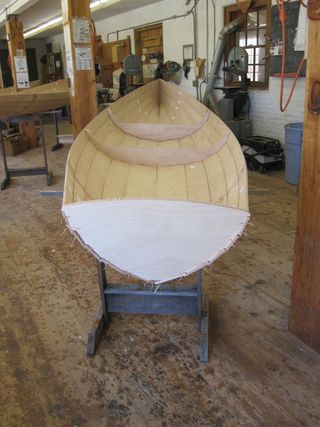
At noon on the second day of boat school, I folded up the
lines of plywood I had stitched together with copper wire. Before me rested
over seventeen feet of something that had the shape of a boat. It would sink, but
it had the feel of water about it. I was not particularly proud of my
accomplishment. All I had done was follow the careful but relaxed directions of
the teacher, a master boat builder named Geoff Kerr. What I had done to arrive
at my boat-like creation was all pretty basic. Drilled a few holes, cut copper
wire, slipped the wire through the holes and twisted them tight. My thumbs were
sore, my back a bit achy from standing and bending over for so many hours; I
had not done anything technically difficult. No wood to cut. No precision to
anything I had done. “Six inches between holes?” I had asked. “About, just eye
ball it.” Whatever might go wrong could be fixed. Nothing that sanding, epoxy
and paint could not fix.
At noon on the second day of boat school, I folded up the
lines of plywood I had stitched together with copper wire. Before me rested
over seventeen feet of something that had the shape of a boat. It would sink, but
it had the feel of water about it. I was not particularly proud of my
accomplishment. All I had done was follow the careful but relaxed directions of
the teacher, a master boat builder named Geoff Kerr. What I had done to arrive
at my boat-like creation was all pretty basic. Drilled a few holes, cut copper
wire, slipped the wire through the holes and twisted them tight. My thumbs were
sore, my back a bit achy from standing and bending over for so many hours; I
had not done anything technically difficult. No wood to cut. No precision to
anything I had done. “Six inches between holes?” I had asked. “About, just eye
ball it.” Whatever might go wrong could be fixed. Nothing that sanding, epoxy
and paint could not fix.
On the first night at the Wooden Boat School, Rich, the generous
and welcoming director, asked everyone to introduce themselves. One man ran a
boat yard down the way and wanted to learn bronze casting; another owned four
boats and needed to know more about diesel engines. A few from the coast guard
were there to learn how to inspect wooden boats. Many people were repeat
students. What was I doing there? All I knew was that I wanted to be a student
for a while, to learn something new that had nothing to do with books or words.
My class was to build an Annapolis
Wherry, a boat I had never seen or rowed but for some reason fell in love with
the sleek lines when I saw an image on the internet. In other words, this was a
version of internet dating, impulsive and perhaps all wrong.“Do you row?” people asked, trying to
understand why I was building this boat, which is 34 inches wide, and rows like
a crew boat, with a sliding seat. Nope. “Is this a stitch and glue boat?” I had
no idea. “Is it made of plywood.”
Probably. (One week later I could say yes, and yes to these last
questions).
I have not built many things in my life. In grade school I
bought balsa wood airplane models and under the guidance of Woogie Ham (not an
invented name; the boy was teased) did a lousy job of gluing them together. I
did not have the patience for the meticulous work of airplane building. Since
then I had acquired a few tools, though I used my drill mostly to hang pictures
on the wall or curtains in the bedroom. But I do have faith that with the right
instruction I can do anything, and that anything can be taught. I wanted to
learn, to be the student, not the teacher.
I am a teacher. I teach creative writing, the personal essay
and nature writing at Bard College. As my students struggle to get their
experiences into beautiful prose, I too also often say, “it will be ok, a
little sandpaper, a little paint, and we can figure this out. Just keep going.”
Determination, going into the writing every day, twisting those bits of copper wires
even if the act of twisting is not inspired, is as essential as the great idea.
Building is building, whether a sentence or a boat.
I was building my boat in the home town and final resting
place of one of the great writers and teachers of writing, E.B. White. For a
clean sentence he can’t be beat. His Elements of Style so often guides me: write
with nouns and verbs. Use the active voice. Don’t place words in the negative
if you can write it in the positive. In tribute to White, I have named my boat
To build something beautiful, truly radiant, I am sure that
it takes more than following the steps. Still, rules are helpful. Stir the
epoxy well. Try not to leave globs, but if you do you can sand them off later.
Try not to use adverbs, but if you do, edit them out later. And it helps to
have a teacher confident enough in his craft to let you make mistakes and still
believe it will all work out.
And lo, at the end of the week, I had a boat. Still not
something that would float—all those holes I drilled now needed to be filled
in--but I was getting closer. It gleamed in the light as I loaded it onto the
roof of my car. I have a few weeks of work left to do—filling and sanding,
daily work that with patience will add up to something called boat.
At the same time, with Elements of Style at my side, I will
be editing my manuscript about kayaking the Hudson River. Daily work that with
patience will add up to something called book.
.
